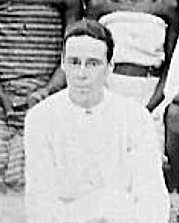Alice Seeley Harris - Human Rights Pioneer
Born: May 24, 1870, Malmesbury, United Kingdom
Died: November 24, 1970, Guildford, United Kingdom
Alice Seeley Harris was a missionary and pioneering photographer who risked her safety to reveal injustice and fight for the dignity of the Congolese people.
Alice was one of the first people to use photography to fight for human rights. Born in Somerset, England, in 1870, Alice grew up in a Christian family that believed in serving others. From an early age, she was troubled by poverty and child labor, which she witnessed in the factory where her father worked. These experiences shaped her deep sense of compassion and justice.
In 1898, Alice married John Hobbis Harris, a Christian missionary who shared her calling. Only four days after their wedding, the couple set sail for Africa to serve in the Congo Free State, a territory then controlled by King Leopold II of Belgium. At first, they planned to teach literacy and share the gospel. But soon after arriving, they discovered a reality far darker than they ever imagined.
The Congo Free State was being exploited for its rubber, a commodity in high demand in the late 1800s. To force the Congolese to harvest rubber, Leopold’s private army, the Force Publique, used violence and terror. Entire villages were burned, women were raped, and people were mutilated or killed. Historians estimate that between one and fifteen million people died during this period.
One encounter in 1904 changed Alice’s life. A man named Nsala came to their mission after soldiers attacked his village. He carried a bundle wrapped in leaves, which held the severed hand and foot of his young daughter. Soldiers had killed and mutilated his family because he had not collected enough rubber. Shocked, Alice asked Nsala to sit on her porch while she photographed him. The image would become one of the most powerful pieces of evidence against Leopold’s regime.
Alice had brought a Kodak Brownie camera, one of the first portable models. She had planned to photograph nature, but instead she documented the brutal realities of colonial rule. Her black-and-white photographs of men, women, and children with missing limbs became some of the earliest examples of photography being used in a human rights campaign.
The Harrises began sending letters and photo slides back to Europe. Their images soon gained international attention. They launched the “Congo Atrocities Lecture,” a lantern slide show that combined Alice’s photographs with narration. They traveled through Europe and the United States, holding over 200 meetings in 49 cities. Audiences were horrified, and pressure against Leopold began to grow.
Writers and activists also joined the fight. In 1905, Mark Twain published King Leopold’s Soliloquy, mocking the king’s cruelty and praising the “incorruptible Kodak” that had exposed him. By 1908, the outcry became too great, and Leopold was forced to give up personal control of the Congo Free State. The Harrises’ efforts helped turn the tide of public opinion.
For the rest of their lives, Alice and John continued humanitarian work. They became secretaries of the Congo Reform Association and campaigned against slavery and exploitation. The Congo was harsh and dangerous, and their activism put them at risk. They were harassed, denied supplies, and even shot at. Yet Alice never gave up. She believed deeply in the Christian call to “love your neighbor as yourself” and felt that God had placed her in the Congo for “such a time as this.”
Alice lived to be 100, passing away in 1970. She never sought recognition, even after her husband was knighted in 1933, making her “Lady Harris.” She often insisted, “Don’t call me Lady!”
Today, Alice Seeley Harris is remembered as a pioneer who used photography to awaken the world to injustice. Her courage shows how one person, armed only with a camera and a conviction to tell the truth, can change history.
References:
“Brutal Exposure: The Congo.” National Museums Liverpool, www.liverpoolmuseums.org.uk/whatson/international-slavery-museum/exhibition/brutal-exposure-congo#section--the-exhibition.
Diansana, Michée. “Alice Seeley Harris: Bringing horror to life in images.” IOSR Journal of Humanities and Social Science, vol. 29, no. 10, Oct. 2024, pp. 01–04, https://doi.org/10.9790/0837-2910080104.
Photography to Support Change | Europeana, www.europeana.eu/en/exhibitions/a-female-lens/photography-to-support-change.
Stanton, Christina Ray. “A Turn-of-the-Century Missionary Who Stood Up to a King.” The Banner, www.thebanner.org/columns/2022/11/a-turn-of-the-century-missionary-who-stood-up-to-a-king.
Keywords:
Civil Rights, Justice, Courage, Conscience, Responsibility, Repair the World – Tikkun Olam, Challenge Injustices, Stand Up for Your Beliefs
Explore ARTEFFECT projects about this Unsung Hero:
Alice Seeley Harris Artworks

